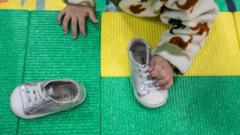In the land of the world's lowest birth rate, South Korea has witnessed a surge in demand for fertility treatments as cultural attitudes toward family planning shift. Kim Mi-ae, a 36-year-old woman from Seoul, shared her experience of the lengthy waiting times at fertility clinics, reflecting a nationwide trend. The number of fertility treatments rose nearly 50% from 2018 to 2022, with one in six babies in Seoul born through assisted methods last year.
Experts attribute this increase to a younger generation desiring control over their reproductive choices. Professor Sarah Harper from Oxford University emphasized how modern women are choosing to plan their family. In response to a declining birth rate that plunged to 0.72 in 2023, government actions to address the demographic crisis have shown modest effectiveness, with a slight uptick to 0.75 projected for 2024.
Many young couples, like Park Soo-in and her husband, are opting for fertility treatments after delayed family planning due to social and financial pressures. The desire for children remains strong, albeit hindered by obstacles such as rising costs and demanding work schedules.
The South Korean government has introduced subsidies for fertility treatments; however, significant out-of-pocket expenses continue to burden couples embarking on this journey. Despite these challenges, the renewed hope for family expansion remains as women like Jang Sae-ryeon navigate the emotional ups and downs of infertility treatments.
In summary, the latest trends reveal that while societal and economic challenges continue to affect family planning significantly in South Korea, a burgeoning fertility industry reflects a hopeful shift towards addressing the nation’s low birth rate, paving the way for potential demographic recovery.
Experts attribute this increase to a younger generation desiring control over their reproductive choices. Professor Sarah Harper from Oxford University emphasized how modern women are choosing to plan their family. In response to a declining birth rate that plunged to 0.72 in 2023, government actions to address the demographic crisis have shown modest effectiveness, with a slight uptick to 0.75 projected for 2024.
Many young couples, like Park Soo-in and her husband, are opting for fertility treatments after delayed family planning due to social and financial pressures. The desire for children remains strong, albeit hindered by obstacles such as rising costs and demanding work schedules.
The South Korean government has introduced subsidies for fertility treatments; however, significant out-of-pocket expenses continue to burden couples embarking on this journey. Despite these challenges, the renewed hope for family expansion remains as women like Jang Sae-ryeon navigate the emotional ups and downs of infertility treatments.
In summary, the latest trends reveal that while societal and economic challenges continue to affect family planning significantly in South Korea, a burgeoning fertility industry reflects a hopeful shift towards addressing the nation’s low birth rate, paving the way for potential demographic recovery.


















